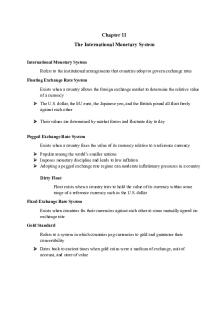Chapter 11c - Lecture notes 11 PDF

| Title | Chapter 11c - Lecture notes 11 |
|---|---|
| Course | Consumer Behavior |
| Institution | Brandman University |
| Pages | 2 |
| File Size | 64 KB |
| File Type | |
| Total Downloads | 60 |
| Total Views | 131 |
Summary
These lecture notes were written for the MKTU 320 course taught by Professor April Simmons....
Description
Chapter 11 Pricing Strategies
Price Adjustment Strategies Companies usually adjust their basic prices to account for various customer differences and changing situations. Here we examine the seven price adjustment strategies summarized in Table 11.2: discount and allowance pricing , segmented pricing, psychological pricing, promotional pricing, geographical pricing, dynamic pricing, and international pricing.
Discount and allowance pricing reduces prices to reward customer responses such as paying early or promoting the product •
Discounts—cash, quantity, trade, seasonal
•
Allowances—trade-in, promotional
Discounts are either cash discount for paying promptly, quantity discount for buying in large volume, or functional (trade) discount for selling, storing, distribution, and record keeping. Allowances include trade-in allowance for turning in an old item when buying a new one and promotional allowance to reward dealers for participating in advertising or sales support programs. One form of discount is a cash discount, a price reduction to buyers who pay their bills promptly. A typical example is “2/10, net 30,” which means that although payment is due within 30 days, the buyer can deduct 2 percent if the bill is paid within 10 days. A quantity discount is a price reduction to buyers who buy large volumes. A seller offers a functional discount (also called a trade discount) to tradechannel members who perform certain functions, such as selling, storing, and record keeping. A seasonal discount is a price reduction to buyers who buy merchandise or services out of season. Allowances are another type of reduction from the list price. For example, trade-in allowances are price reductions given for turning in an old item when buying a new one. Trade-in allowances are most common in the automobile industry but are also given for other durable goods. Promotional allowances are payments or price reductions that reward dealers for participating in advertising and sales support programs.
Segmented pricing is used when a company sells a product at two or more prices even though the difference is not based on cost
Companies will often adjust their basic prices to allow for differences in customers, products, and locations. In segmented pricing, the company sells a product or service at two or more prices, even though the difference in prices is not based on differences in costs.
•
Customer-segment pricing
•
Product-form pricing
•
Location-based pricing
•
Time-based pricing
Segmented pricing takes several forms. Under customer-segment pricing, different customers pay different prices for the same product or service. Museums and movie theaters, for example, may charge a lower admission for students and senior citizens. Under product-form pricing, different versions of the product are priced differently but not according to differences in their costs. For instance, a round trip economy seat on a flight from New York to London might cost $1,000, whereas a business class seat on the same flight might cost $4,500 or more. Although business class customers receive roomier, more comfortable seats and higher quality food and service, the differences in costs to the airlines are much less than the additional prices to passengers. However, to passengers who can afford it, the additional comfort and services are worth the extra charge. Using location-based pricing, a company charges different prices for different locations, even though the cost of offering each location is the same. For instance, state universities charge higher tuition for out-ofstate students, and theaters vary their seat prices because of audience preferences for certain locations. Finally, using time-based pricing, a firm varies its price by the season, the month, the day, and even the hour. For example, movie theaters charge matinee pricing during the daytime, and resorts give weekend and seasonal discounts.
To be effective: •
Market must be segmentable
•
Segments must show different degrees of demand
•
Costs of segmenting and reaching the market cannot exceed the extra revenue obtained from the price difference
•
Must be legal...
Similar Free PDFs

Chapter 11c - Lecture notes 11
- 2 Pages

Chapter 11 - Lecture notes 11
- 9 Pages

Chapter 11 - Lecture notes 11
- 3 Pages

Chapter 11 - Lecture notes 11
- 7 Pages

Chapter 11 - Lecture notes 11
- 5 Pages

Chapter 11 - Lecture notes 11
- 17 Pages

Chapter 11 - Lecture notes 11
- 15 Pages

Chapter 11 - Lecture notes 11
- 12 Pages

Chapter 11 - lecture notes
- 4 Pages

Chapter 11 - Lecture notes 13
- 4 Pages

Chapter 11 - Lecture notes 9
- 5 Pages

Chapter 18 - Lecture notes 11
- 7 Pages
Popular Institutions
- Tinajero National High School - Annex
- Politeknik Caltex Riau
- Yokohama City University
- SGT University
- University of Al-Qadisiyah
- Divine Word College of Vigan
- Techniek College Rotterdam
- Universidade de Santiago
- Universiti Teknologi MARA Cawangan Johor Kampus Pasir Gudang
- Poltekkes Kemenkes Yogyakarta
- Baguio City National High School
- Colegio san marcos
- preparatoria uno
- Centro de Bachillerato Tecnológico Industrial y de Servicios No. 107
- Dalian Maritime University
- Quang Trung Secondary School
- Colegio Tecnológico en Informática
- Corporación Regional de Educación Superior
- Grupo CEDVA
- Dar Al Uloom University
- Centro de Estudios Preuniversitarios de la Universidad Nacional de Ingeniería
- 上智大学
- Aakash International School, Nuna Majara
- San Felipe Neri Catholic School
- Kang Chiao International School - New Taipei City
- Misamis Occidental National High School
- Institución Educativa Escuela Normal Juan Ladrilleros
- Kolehiyo ng Pantukan
- Batanes State College
- Instituto Continental
- Sekolah Menengah Kejuruan Kesehatan Kaltara (Tarakan)
- Colegio de La Inmaculada Concepcion - Cebu



